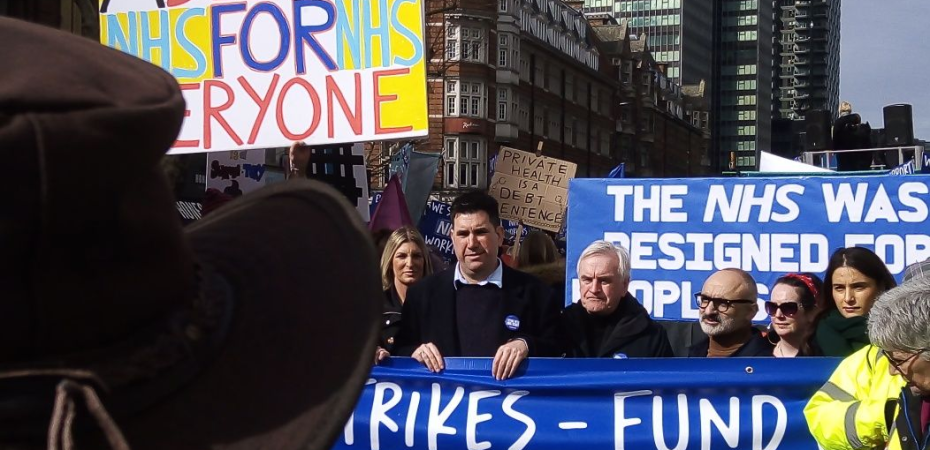Liz Peretz’s speech at Saturday’s Socialist Health Association Conference marking 75 years of the NHS
Why is it worth opening the Conference with some words about the 1930s – what health services looked like then, before the NHS, and what was the state of people’s health at the time?
First, we are back, thanks to austerity, to breathtaking inequalities not so different from those in the 1930s. Children’s height is reducing year on year, they go without meals, without heating. Chronic ill-health – physical and mental – is increasing to levels not unfamiliar 90 years ago.
Second, while we still have our NHS free at the point of need, underfunding, private sector plundering, 40 years of being forced to act on business principles to tighten the belt and balance the books, have brought us to the brink of the chaotic, fragmented world of British health services described by contemporaries in the 1930s. It’s as well we peer into the past to see what might be ahead.
And third – and to my mind most importantly – those contemporary commentators developed plans for the future, with blueprints and red lines, principles and prescriptions, which give some interesting lines of thought for us – as all parties are beginning to limber up for their manifestos, and as unions, professional groups, campaigners and patients pull together thoughts for the future.
The clearest and most straightforward prescription for a future ideal health service I’ve drawn on is that of the Socialist Medical Association, the original name of the Socialist Health Association, first delivered to an appreciative Labour Party Conference in 1932 by our first Secretary and President, Dr Somerville Hastings, MP for Reading – who would have been incandescent about Thames Water.
Following hot on its heels was the 1937 report The British Health Services (begun in 1934) of an independent think-tank, Political and Economic Planning (PEP for short), whose key members had been trained by John Maynard Keynes, unashamedly capitalist while believing in state intervention.
Both start with a clear message our government doesn’t seem to have understood: it is in our national interest to have a well, content population. The costs of ill-health far outweigh, 8:1, the costs of a decent all-round health service – prevention is in the long run much cheaper than simply concentrating on illness.
Here is a quote: “The more careless about health the community is, and the more often its members need serious doctoring, the worse doctoring they are likely to get because the cases coming up for attention will be too many and at too late a stage.”
Then there are the costs to the nation of working days lost, benefits, compensations – in 1936 the government paid out £12m to workers in compensation for accidents. Health here includes clean water, good working conditions, healthy eating, physical exercise, decent housing and an end to overcrowding. To quote the PEP report: We need to “create boldly and consciously the conditions in which a healthy population could grow and flourish.”
A second message: profit making firms should be removed from our health services. Another quote: “Cunning swindlers… deliberately… exploit for their own profit… the credulity of the public.” This might be over-the-counter ‘cures’ or nursing home places, or private doctors overprescribing or telling their patients what they want to hear.
There was no profit to be made in promoting health, or dealing with mould in housing, so ‘health’ services remained ‘sickness’ services; and you were often ‘treated’ for something with expensive ‘quack’ cures over-the-counter which never meant to live up to their advertising campaign, only to make a quick profit. And profit makers thrive on competition, not co-operation – whereas health needs the highest level of co-ordination and cooperation to be effective.
Which brings me to message number three. Detailed surveys like the 1937 report reveal an extraordinary fragmented patchwork of health services – more like a set of unassembled ill-matched patches, overlapping in some places, entirely absent in others. Public, old poor law, voluntary, private, paid for by donation, contribution, insurance, government grant – every part of the country totally different, even down to the level of means testing.
This chaos went on despite the Ministry of Health – established in 1919 to improve the nation’s health. In the 1930s in Merthyr if you fell pregnant you had to rely on the charitable ladies bringing you free milk and marmite from London to their grace and favour clinic; in Tottenham you had the full array of free (very generous means testing terms) clinics before and after the baby arrived.
The reason for the national chaos? Too much arms-length ‘regulation’ which led to poor practice – lots of Tory authorities turning a blind eye, not inspecting regularly enough, not employing enough inspectors. Despite around five pieces of legislation and much handwringing, still in 1935 one mother in 260 died in childbirth. Life expectancy had only improved by five months since 1871 – in fact in some areas it was sliding backwards from the 1920s figures.
Lesson? Permissive legislation isn’t enough, and ‘monitoring’ doesn’t ensure a decent service, let alone improving it A nation needs a better grip than that.
Also an examination of the much trumpeted National Insurance scheme – out of which came the panel doctor for those in employment only, not their families and dependents – reveals another nightmare. There were something like 20,000 small insurance schemes and approved or friendly societies all connected to NI, all of which gave different levels of help if you were ill. With employers like Morris in Oxford, who operated by regular lay-offs of weeks at a time, this wasn’t even working for the workers – and it was not concerned with promoting health, or chronic debilitating conditions.
Insurance is not the way. Nor were the myriad of contributory schemes – twopence for a family every week for a district nurse, a shilling for the GP for the whole family, and another twopence for the hospital. Every area had different rates and services – another nightmare that didn’t help the poorest, and also didn’t ensure the services which were in dire need of state support in the late 30s.
So to the blueprint. Health not sickness – both reports came up with very similar plans. For both, the key person was the family practitioner, working with colleagues in a beautifully equipped, publicly owned health centre with well-paid nurses, health visitors, midwives, district and practice nurses, secretaries.
All the staff would be fully salaried through state funds All the staff would be given free training, open to students from all social classes; all doctors with a case load that allowed them to really get to know their patients, their housing conditions, their family relationships – a small enough work load that they could do regular checkups, spend time on research, on discussing cases with colleagues.
The two blueprints also included public health directors (then called a Medical Officer of Health, or MOH), salaried through the local authorities and with local responsibility for the range of sanitation, infectious disease control, good housing, workplace health, clean water, good drainage, nutritious subsidised food, and school health. Medical Officers of Health and the local GPs would meet regularly to discuss outbreaks of scarlet fever, or how to tackle poor workplace conditions, or water. These very local twin services – tackling ill health and the social determinants of health together – would come under a local democratic Medical Committee, under a Ministry of Health, with expanded statutory powers and the funds to match.
The hospital service would also be addressed. At the time such an impossible overlapping and still inadequate muddle of private, public, municipal and voluntary institutions, would be firmly co-ordinated into a set of general hospitals, many with teaching facilities, to which the family practitioner could refer his or her patients. It would also staffed with publicly trained and salaried specialists and nurses.
How were the public to have access? Here there was a divergence in approach: the PEP recommended some kind of means tested small fee to the public – possibly through insurance – but not to fees that would deter those on low incomes. The Socialist Medical Association were unequivocal. The authors of The People’s Health demanded free-to-all access not just at the point of need, or sickness, to the whole range of doctors, nurses, hospital specialists, clinics, but also in health, for regular check-ups and advice.
Points for today’s SHA conference? Well, we still have a free at the point of need NHS, but the whole range of services needed to tackle the social determinants of health and indeed prepare for future pandemics is in tatters. The 1930s Medical Officers of Health were in many ways more prepared than we are, with isolation hospitals, fever nurses, special ambulances and public health education always on the alert.
Striving for health and happiness not just the absence of sickness – recognising that the costs of ill-health well outweigh the costs of providing services to promote good health – should be core to any social democratic, not just socialist, manifesto.
All existing public municipal and voluntary hospitals were co-opted into a coherent service in 1948, whatever their origin. They were all needed – and more – to ensure enough beds for the nation. A rational approach to the bed issue today might also propose co-option of the private stock, as well as the refunding of hospitals so they can reopen beds wards and operating theatres. This would be much better for long term planning than handing money to private hospitals to clear NHS waiting lists by poaching yet more NHS staff, exacerbating the current NHS hospital crisis.
For the SHA, we should take pride in the 1932 report, but also acknowledge that we still haven’t reached the ideal health service – fully salaried in the publicly provided lavishly equipped local health centres and general hospitals that Somerville Hastings and others envisaged. We continued our criticism, throughout the building of the NHS and long beyond, and indeed some of our members, notably the Tudor Harts, father and son, pioneered in their general practice a lot of the ideas in The People’s Health, including undertaking ground-breaking research.
But one of the key messages – even stronger in the more social democrat PEP report of 1937 than the SMA’s report – was: Keep the Profit Motive Out. And for us all, keeping the profit motive out of our future health services is a lesson that must be learnt.
Our NHS is currently riddled with the contract culture, the burden of PFI and staff who have known nothing else but the purchaser-provider split. Any party manifesto worth its salt will take on that message and plan to act on it. If the 1930s capitalists themselves knew that profit was not the way to the healthy nation surely we can.
Liz Peretz is an Associate Fellow at the Department of Social Policy and Intervention at the University of Oxford
Image: c/o Mike Phipps

